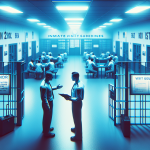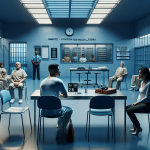Visiting a loved one in prison can be an emotionally challenging and complex process. Knowing how to navigate the visitation process is crucial to ensure you have a successful visit. The Tucker Unit Inmate Visitation Overview is designed to give you the information you need to prepare for a visit.
The first step is to become familiar with the Tucker Unit’s visitation policies and procedures. Prior to the visit, inmates are required to register for a visiting program and send in a visitor request form. Once approved, visitors may schedule a visitation date and time. It is essential to follow all directions and arrive on time.
In addition to the initial paperwork, visitors should also be aware that they may be subject to searching and video surveillance. There are also restrictions on items visitors are allowed to bring into the facility such as cell phones, cameras, and any objects that may be viewed as threat.
When visiting the Tucker Unit, visitors should present their official government identification such as a passport or driver’s license. Additionally, visitors should allow sufficient time to advance their through the security checkpoints.
Finally, the Tucker Unit Inmate Visitation Overview offers information on virtual visits. With virtual visitation technologies, visitors can connect with their loved ones through voice or video conversations via the internet.
In conclusion, the Tucker Unit Inmate Visitation Overview is designed to provide visitors the critical information they need to prepare for a visit. Visitors should understand that visitation policies and procedures may change from time to time, so it is important to stay up to date on the latest information. Knowing the information and properly preparing for the visit will help ensure a successful visit.
Tucker Unit – Overview and Information
A Tucker Unit is a multi-use innovative multi-purpose vehicle designed by Preston Tucker during the 1940s to cater to the specific needs of the military. The vehicle was designed around a variety of interchangeable components, allowing for multiple applications with minimal effort. The Tucker Unit was designed to ride on tracks instead of wheels and featured a turret, a front-mounted machine gun station, and a rear-mounted 20mm anti-aircraft gun. The vehicle could serve both as a personnel carrier and an armored reconnaissance vehicle, making it an ideal tool for a tactical mission.
The Tucker Unit was unique in that it could be rapidly deployed for a vast array of different missions. It could be used to transport troops, tow objects and even serve as an armored personnel carrier or tank. Its high off-road capability was made possible by the suspension and tracks which allowed it to cross terrain that was challenging for wheeled vehicles. The turret could rotate a full 360 degrees and could be raised and lowered which gave the vehicle great flexibility in combat situations. The single-shot 20mm anti-aircraft gun was mounted to the rear of the vehicle and could engage airborne targets as well as lightly armored vehicles.
The Tucker Unit was not limited to just military operations and was also used for civilian applications. It could be adapted to perform tasks such as laying out irrigation systems, serving as a fire truck or an earth mover. It even saw use as a mobile command post, radio communications unit and an ambulance.
Despite its innovative design, the Tucker Unit never saw much use in the military and was eventually phased out. It has since gained a bit of cult-like status amongst collectors and fans of military hardware. The Tucker Unit remains an incredibly versatile and highly useful vehicle for any purpose, and its place in history is secure.
Tucker Unit – Classes, Services, and Programs
The Tucker Unit is a residential treatment center located in Tucker, Georgia. It offers a variety of classes, services, and programs for individuals with mental health issues and substance abuse problems. The center offers a comprehensive range of services, including individual and family therapy, educational classes, recreational programs, and residential housing.
At the Tucker Unit, each client is provided with an individualized treatment plan that includes both on-site and community-based services. Clients are able to attend one-on-one therapy sessions, group therapy sessions, and participate in educational classes to learn skills such as problem-solving, communication, and financial responsibility. The Tucker Unit also has recreational programs available such as arts and crafts, music therapy, and yoga, to encourage a fun and healthy lifestyle.
For individuals with a severe mental health disorder, the Tucker Unit also has specialized residential housing. This allows clients to receive the intensive services they need to effectively manage their condition and live more independently. The residential housing includes 24-hour support staff, skill-building activities, and structured living arrangements.
The Tucker Unit also provides crisis services that are available 24 hours a day, seven days a week. They provide telephone and in-person intervention services, and can provide referrals and support for individuals experiencing severe mental health and/or substance abuse issues.
In addition, the Tucker Unit offers a variety of support services, such as health screenings and transportation assistance. These services help individuals gain access to the medical care and other resources they need to stay healthy and active.
Overall, the Tucker Unit provides an extensive range of classes, services, and programs that are designed to treat mental health issues and substance abuse in the most effective and compassionate way.
Inmate visiting application in Tucker Unit
Visiting a friend or family member who is an inmate in the Tucker Unit requires an application. This application must be submitted at least 14 days prior to the visit, and it can be found at the Texas Department of Criminal Justice website.
When applying for a visiting application in Tucker Unit, the following documents must be included in the submission:
1. An identification card
2. Proof of current address
3. Visiting application form filled out
4. Court documentation about the offender
5. Photo ID or Driver’s license
The visitor must be 18 or older to be eligible to visit, and they may have to provide additional information depending on the status of the inmate.
The applicant must also provide a valid social security number, a copy of the inmate’s visitation form, a money order, and a recent photograph that has been taken within the past 6 months.
In order to schedule a visit once the application is approved, the applicant should contact the Tucker Unit at (512) 868-8700. Visiting hours begin Friday at 8:30 am and end Sunday at 3:30 pm.
Note that visitors are required to register with the visitation center prior to the visit. This can be done from 8 am to 2 pm, Monday through Friday. Also, no weapons are allowed, and visitors are subject to a search.
Visitors must be prepared to present identification such as a state driver’s license, birth certificate, or other valid ID that matches the name listed on the visiting application.
These are the basic steps for applying for visiting at the Tucker Unit. It’s important to make sure that the application is complete and to provide all the necessary documents. Following these steps and meeting the requirements will guarantee a successful application process and help get your visit approved.
Tucker Unit: Frequently Asked Questions and Answers
Tucker Unit: Frequently Asked Questions and Answers
Q: What is the Tucker Unit?
A: The Tucker Unit is a comprehensive evaluation system developed to assess problem solving and critical thinking skills in individuals on the autism spectrum. It is used to measure problem solving strategies when presented with an issue or task. The Tucker Unit consists of a series of tests designed to measure various aspects of problem solving and critical thinking ability, allowing researchers and practitioners to develop an effective treatment plan for individuals on the autism spectrum.
Q: What can the Tucker Unit measure?
A: The Tucker Unit is able to measure a person’s ability to use problem solving strategies to complete tasks or solve problems. This includes understanding a problem, developing a plan to solve the problem, and implementing that plan. It also looks at the individual’s ability to adapt to new situations, think flexibly, and create new solutions to unanticipated challenges.
Q: What information does the Tucker Unit assess?
A: The Tucker Unit assesses both quantitative and qualitative data. Quantitative data includes information such as the amount of time it took for the individual to complete tasks, the number of attempts needed in order to solve a problem, and the accuracy of the individual’s responses. Qualitative data is used to measure a person’s understanding of the problem and how they attempted to solve it. This includes data such as the strategies used to solve the problem and the individual’s ability to think abstractly and flexibly.
Q: Who can administer the Tucker Unit?
A: The Tucker Unit was designed to be administered by a trained professional such as a psychologist or clinical specialist. It is not appropriate for parents or family members to attempt to administer the Tucker Unit without the proper training. A trained professional will be able to assess the individual accurately and potentially find ways to improve the individual’s problem solving and critical thinking skills.






